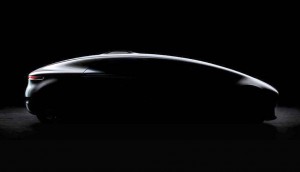
Mercedes offers a tease of the concept car it will introduce at this year's Consumer Electronics Show.
When Mercedes-Benz unveils its new autonomous vehicle concept car this month it will skip the big Detroit Auto Show, turning instead to Las Vegas for the debut.
Like a number of its rivals, the German maker is planning a big presence at the 2015 Consumer Electronics Show. The largest annual event in Sin City, CES is typically a venue populated by TV, smartphone, computer and electronic gadget makers. But it has also become a major staging ground for the auto industry.
“The last three years have really accelerated the role” of the automobile at the electronics show, notes Egil Juliussen, the director of research for the automotive technology group at think tank IHS. It’s because technology is becoming more and important in the car, he adds, noting “people want to use all of their mobile electronics in their cars.”
The automobile may be a fundamentally mechanical machine but it is becoming increasingly dependent on electronic safety, emissions and infotainment systems. High-end automobiles like the current Mercedes S-Class are likely to use as many as 100 microprocessors – more than the typical home or office — as well as sonar, radar, laser and camera sensors.
(Chevrolet offers unexpected preview of 2016 Volt at CES newser. Click Here for more.)
And that’s only likely to increase — as the new Mercedes concept will demonstrate — as the industry begins to roll out new autonomous technologies that can take over for a human driver. Cadillac has promised to put its SuperDrive system – which can operate hands-free on a limited-access freeway — into production by 2016. Nissan plans to start selling a fully autonomous vehicle in 2020.
BMW, meanwhile, plans to show a new Parking Valet system at CES that would allow a vehicle to drop off its passengers, go find a nearby parking spot, then retrieve them when called.
The significance of the CES show to the auto industry is underscored by the high-power presence of such high-ranking executives as Dieter Zetsche, the CEO of Mercedes’ parent Daimler AG, as well as Mark Fields, the new chief executive at Ford Motor Co. Fields’ predecessor, Alan Mulally, was a frequent CES keynoter in recent years.
(For more on the BMW Auto Park Valet system, Click Here.)
Ford will bring to CES its own autonomous vehicle and anti-collision technologies. But it also will show off the third generation of its groundbreaking Sync infotainment system.
While self-driving vehicles may be garnering much of the headline coverage, the more immediate push is into so-called “connected car” technology. Like Ford, Hyundai will be showing off its latest in-car system, dubbed Blue Link. Among other things, it will make it easier to integrate apps from Android and Apple smartphones. And lifting a page from Apple’s playbook, Hyundai also will show off a concept smartwatch that could be used to connect with – and control – its vehicles.
“Connecting to your car through a smartwatch and voice recognition was previously something seen only in science fiction movies,” says Barry Ratzlaff, the executive director of customer connect for Hyundai Motor America. “This new app expands Hyundai’s exploration into how wearable technology and Blue Link fit into a customer’s lifestyle.”
Virtually every aspect of the automobile is undergoing a high-tech transformation mirroring what is happening in the consumer electronics world. Both Audi and McLaren plan to show off what they’re describing as the future of automotive display technologies – which look more like something out of a science fiction film than the classic dials and gauges today’s motorists are familiar with.
(New smartphone system debuting at 2015 CES could replace your car keys. Click Here for more.)
There are some issues unique to the automobile, notably driver distraction. And there will be a number of automakers – and independent vendors – offering possible solutions designed to keep a motorist’s eyes on the road.
The National Highway Traffic Safety Administration has blamed distracted driving for about a tenth of all crash fatalities, but NHTSA also notes that fatigue is responsible for more 1,500 deaths annually. Several makers now use high-tech systems to try to detect when a driver is getting sleepy, Lexus relying on a camera that can watch a driver’s head movements. A start-up named Impecca will bring to CES a new wearable device it claims is 90% accurate at detecting when a motorist is ready to fall asleep behind the wheel by monitoring their brainwaves.
Whether motorists will be willing to strap a band around their head, never mind wear a smartwatch to communicate with their car remains to be seen, but as this week’s CES show will make clear, tomorrow’s cars will become even more dependent on digital technology.
In many ways, says IHS analyst Juliussen, automakers have become some of the most visionary participants at CES, the car itself “certainly the most complex” product at the annual show.
(This story first appeared on NBCNews.com)

